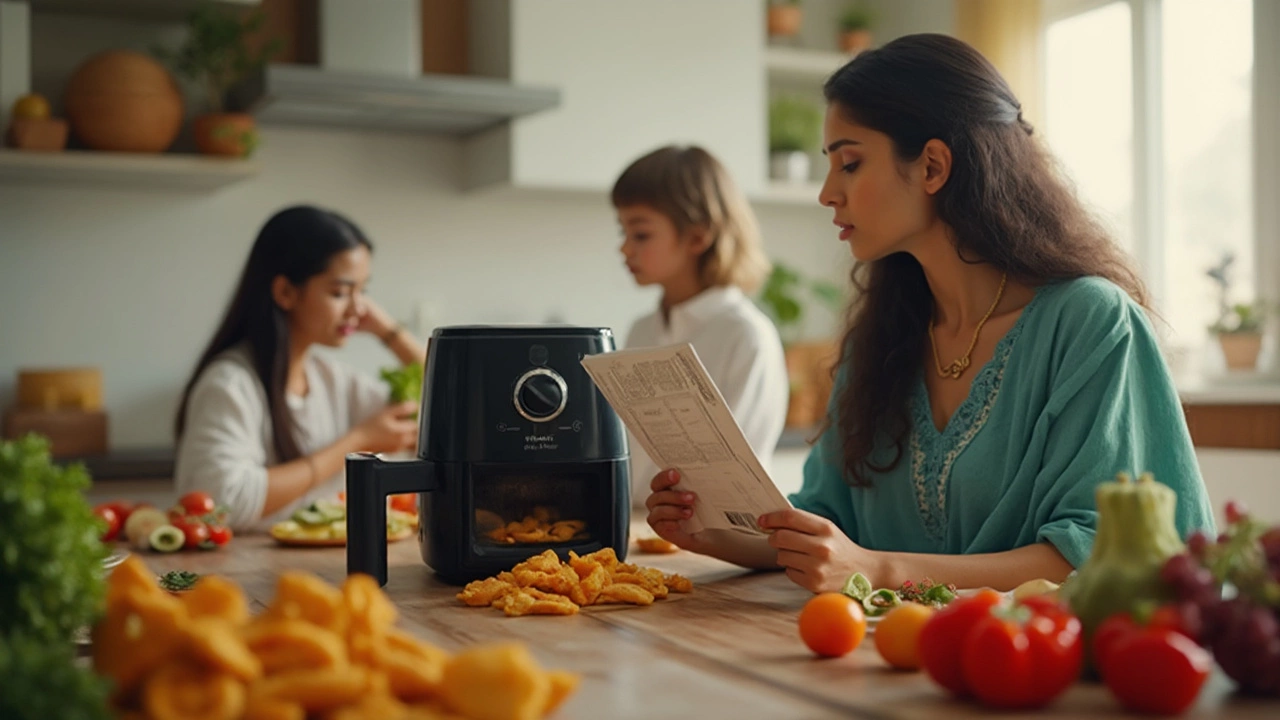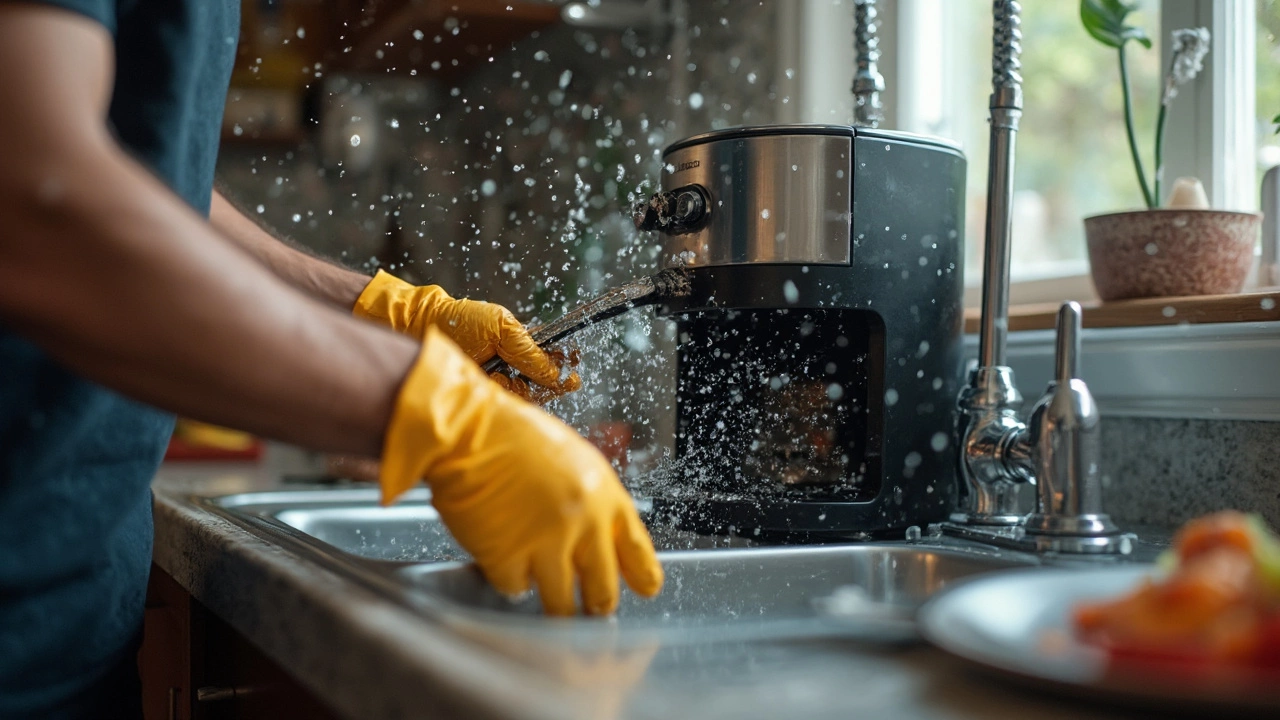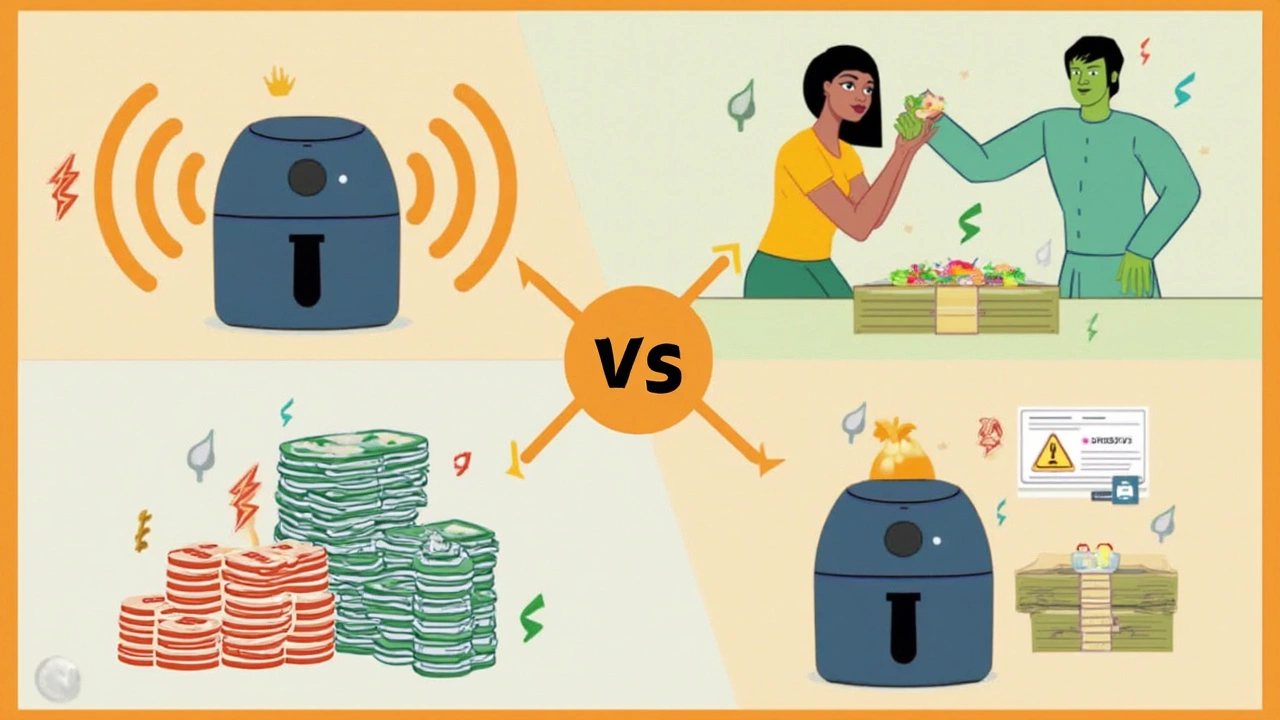
Air fryers look like the answer to every busy person's kitchen dreams, but they bring plenty of headaches that hardly get mentioned in the flashy ads. First thing—think about where you’ll put the thing. Most air fryers are chunky, and even the so-called 'compact' models can hog a ton of space on your counter. That pushy, spaceship look doesn’t fit neatly into every kitchen.
Ever noticed a weird plastic or chemical smell the first few times you use new appliances? Air fryers sometimes reek even longer. That odor can cling to your food, especially in the early days. And if you think you’ll get the same taste or texture as frying in oil—yeah, prepare for disappointment. Fries can end up hard on the outside, dry inside, and chicken sometimes tastes more like it just went through the Sahara than a tasty deep fryer.
- Space and Size Problems
- Weird Smells, Tastes, and Texture Issues
- Health Myths and Truths
- Maintenance and Cleaning Headaches
- Real Costs: Noise, Energy, and Repairs
Space and Size Problems
Air fryers aren’t the tiny gadgets you see in online ads. These things are pretty big and heavy compared to your regular toaster or coffee maker. A basic model usually takes up the same space as a mid-sized slow cooker. If you live in a small apartment or just have a regular-sized kitchen, squeezing an air fryer onto your countertop feels like playing kitchen Tetris. And don’t forget—you need to leave space around it so it doesn’t overheat.
Some air fryer baskets hold barely enough for one person, so if you’re cooking for a family, you’ll either end up running several batches or need one of those family-sized units, which eat up even more counter space. According to a recent CNET review, "Most air fryers take up at least as much space as a stand mixer, and the larger ones can be as bulky as a microwave."
CNET: "Most air fryers take up at least as much space as a stand mixer, and the larger ones can be as bulky as a microwave."
Here’s what you actually get when it comes to air fryer sizes:
| Type | Average Capacity (quarts) | Counter Space Needed |
|---|---|---|
| Small | 2-3 | About 12" x 10" |
| Standard | 4-6 | About 16" x 13" |
| Family size | 7+ | Over 18" x 15" |
If you want to keep your counter from turning into a gadget parking lot, you’ll have to put your air fryer away after each use. But let’s be honest, these things are awkward to move and they need time to cool down first. If you plan to use it every day, you pretty much have to let it take up prime real estate in your kitchen.
- Measure your counter space before you buy any air fryer.
- Consider storage—most regular kitchen cabinets won’t fit a bulky air fryer.
- Expect to give up some workspace for the air fryer to sit safely.
If you’re all about getting in on air fryer negatives, the size hassle is hard to ignore. For anyone on the hunt for air fryer deals, double-check those specs—not just the price tag—so you don’t end up with a gadget that won’t fit anywhere.
Weird Smells, Tastes, and Texture Issues
One thing that trips up a lot of new air fryer owners is the strange smell that hits right after you set it up. Early on, you might catch a whiff of what smells like burning plastic or chemicals. This comes from how the air fryer negatives play out, especially with cheaper models or when you don't do an initial 'burn-in' run to clear out manufacturing residue. Some brands even mention in the manual to run the fryer empty before the first real use, which helps a bit but doesn’t always fix it totally.
The weird smell can linger for the first few uses, and it sometimes messes with the flavor of your food. Instead of crisp fries and nuggets, you end up with a faint taste of plastic or a rubbery aftertaste. Not exactly what you pictured when you saw those crispy wings on TikTok.
Alright, let's talk about texture. Air fryers promise crunch without oil, but real talk—results can be a gamble. Fries might be tough outside and dry inside, and breaded foods can turn out more chewy than crispy. The lack of oil just means there's less moisture locking in that fluffiness or juiciness that good old-fashioned frying gives. You can try spritzing with a little oil spray, but it still falls short of classic deep-fried perfection.
Even frozen foods aren’t safe. Mozzarella sticks crack open and ooze cheese all over the tray, while battered fish sticks might lose their crust and come out sad and soggy. The air flow isn’t always even, so you could get some bites extra dry and others not fully done.
Check out this quick rundown from user surveys in 2024 on the top food problems new air fryer owners faced:
| Food | Common Complaint | % of Owners Reporting |
|---|---|---|
| French Fries | Dry texture | 49% |
| Chicken Wings | Tough skin, uneven cooking | 38% |
| Frozen Mozzarella Sticks | Cheese leaks out, soggy crust | 33% |
| Battered Fish Sticks | Soggy, chewy texture | 27% |
To fight weird smells and tastes, run your air fryer empty at max temp for 10 minutes before the first use. For texture problems, preheat the air fryer, don’t crowd the basket, and give foods a light spray of oil if you want that extra crunch. Just don’t expect miracles every time.

Health Myths and Truths
If you think an air fryer is a magic ticket to perfect health, you’re not alone. Ads make it sound like swapping your regular fryer for an air fryer is all you need. But the air fryer negatives do include some overhyped promises, especially around health.
Let’s clear things up. Yes, air fryers use less oil—sometimes up to 80% less than deep fryers. That’s good if you’re watching your fat intake. But that doesn’t turn French fries or chicken wings into a daily health food. The calories and sodium are still there, and you can prank yourself into overeating because you think they’re “healthy fries now.”
“Air frying can help reduce the amount of oil, but there’s little evidence it makes fried foods actually healthy. You still need to watch portions and ingredients.” — Dr. Jorge Moreno, Yale School of Medicine
Ever heard that air fryers cut out all harmful compounds? Here’s the truth: air-frying at high heat can still make acrylamide, the same stuff found in fries and chips that’s linked to cancer risk. A 2022 study compared fries cooked four different ways and found the acrylamide level in air-fried potatoes was 50% less than deep-fried, but it was not zero.
| Cooking Method | Acrylamide (ppb) |
|---|---|
| Deep Fryer | 1200 |
| Air Fryer | 600 |
| Oven Roast | 750 |
| Boiled | 20 |
And not everything is a win: cooking battered foods in an air fryer doesn’t usually work out. The breading dries out or flakes off, and that makes for a pretty sad chicken nugget.
- Don’t rely only on the air fryer to “health up” fried snacks. It helps, but it’s not a game-changer by itself.
- Go easy on using processed, salty frozen foods in your fryer—they’re still loaded with stuff your heart doesn’t love.
- If you’re looking for real health gains, try air frying veggies, not just fries.
Bottom line: air fryers are better than heavy oil frying, but don’t expect miracles. It’s still a kitchen gadget, not a doctor.
Maintenance and Cleaning Headaches
This is where most air fryer owners start grumbling—keeping these things clean can be a royal pain. Sure, the ads say “easy to clean,” but anyone who’s cooked a batch of sticky wings or cheesy snacks knows the mess left behind. Fat, crumbs, and gunk build up in hard-to-reach spots. Taking the basket and tray apart isn’t always straightforward. Some have awkward crevices that even scrub brushes struggle to reach.
Lining the basket with parchment might sound like a good hack, but the high-speed fan can blow it around, sometimes into the heating element (bad idea). And don’t expect every part to be dishwasher safe, even if the box claims it. Some baskets get warped or faded after a few washes, and you might notice peeling nonstick coating—no one wants flakes of that in their dinner.
For a deep clean, you have to get greasy residue off the heating coil—which the manual usually says NOT to touch. Steam cleaning doesn’t always do the trick, and using aggressive cleaners? That can mess up the finish or leave weird smells for the next meal.
- Let the basket and pan cool before trying to clean—hot oil burns are a thing.
- A toothbrush or bottle brush helps with corners, but plan on scrubbing, not just rinsing.
- Always check for food stuck to the fan or heating element, but be careful not to bend, poke, or chip anything.
It’s no surprise that some folks just give up and let that “air fryer smell” stick around. If upkeep is high on your list, you might want to rethink chasing air fryer negatives if you’re all about easy living in the kitchen.

Real Costs: Noise, Energy, and Repairs
A lot of folks jump at a good deal and snag an air fryer, but the sticker price doesn’t tell the full story. Owning one can poke holes in your wallet in weird ways. You might notice right away that the thing is louder than you expect. When it’s running, the fan and heating element make a whirring noise that’s kind of like a dryer mixed with a hair fan. Some brands are quieter, but even then, it’s tough to have a phone call right next to one. For open kitchens and apartments, it gets annoying fast.
Energy use is another forgotten expense. Air fryers use between 1,200 and 2,100 watts per session. Compare that with a microwave (usually under 1,000 watts) or even an oven (which uses more, but cooks bigger batches). Since air fryers make smaller portions, you’ll probably do more cycles if you’ve got a hungry household. Here’s a real look at how the numbers stack up:
| Appliance | Average Power (Watts) | Typical Use (Minutes per session) |
|---|---|---|
| Air Fryer | 1600 | 15-30 |
| Microwave | 900 | 3-8 |
| Toaster Oven | 1400 | 10-20 |
| Oven (full size) | 2500 | 30-60 |
If you’re running the air fryer every day, those numbers add up. Not crazy high, but definitely not as 'low energy' as the ads sometimes suggest.
Then comes repairs and replacement parts. Air fryer baskets tend to lose their nonstick coating, sometimes in as little as six months. A replacement basket can cost almost as much as a cheap new fryer. Buttons can fail, and digital displays sometimes just blink out. Unlike toasters or kettles, you usually can’t fix these things at home. You’ll either fork out for a repair (and wait weeks), or just toss it and buy a whole new one—definitely not great for your budget or the environment.
- Plan where you’ll put it before buying to avoid accidents and kitchen mess.
- Ask about replacement part prices when shopping for deals.
- Check out decibel ratings if noise bugs you—you can find quieter models with a bit of research.
- Remember, using your air fryer negatives knowledge can save you surprise costs in the long run.